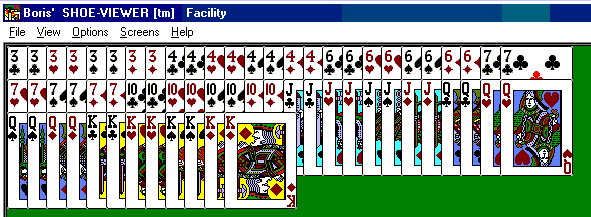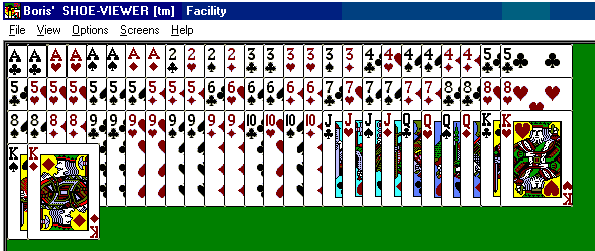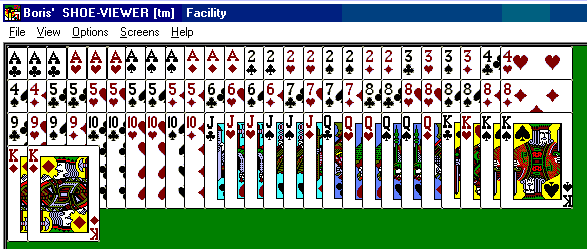
Practice Decks
How and Why to make them
Part II
Learning to drill a
Multi-Level Count
In the first installment of this article series, I introduced the importance of routinely running practice drills designed to hone individual Blackjack skills. We looked at Practice-Decks; what they are, how to make them, and how to utilize them in your practice activities. To illustrate the concept, I introduced the Boris Ace-Five Count; a 1-level count designed not only to gain a minute statistical edge over the house, but also to set the stage for learning more complex, multi-level count methods.
Blackjack's math-weenies will argue that Boris' Ace-Five count is multi-level because of the +3/-3 number's. However, +3/-3 are the ONLY numbers in the count, so in my mind we are still utilizing a 1-level system, regardless of any fancy argument you may advance otherwise. Besides, it is an irrelevant point - either a strategy delivers what it promises or it does not... it's THAT simple.
In this article installment we are going to take the idea of designing Practice-Decks one step further by designing decks allowing us to learn a typical Multi-parameter count method; such as Boris' Advanced Count, which I will use as an example.
The
Boris Advanced Count - Point Values
In the first article, I mentioned that Boris' Advanced Count came about as an attempt to remedy the practical difficulties inherent with Uston APC. It has been brought to my attention by one of Uston's Blackjack students that the UAPC was actually not Ken's creation. In the 70's it was known by Blackjack dealers on the strip as the "Wonderful-Wonderful Count". Ken simply "borrowed" it, adapting it to his style of play.
Like the UAPC, the chosen
card-values in Boris' Advanced Point Count are designed to reflect
the fact that each card contributes to the game differently; some in
favor of the player; some in favor of the dealer.
Like the UAPC, Boris'
Advanced Count is a "Balanced" Count; the minus-values
cancelling out the plus.
The card-values for Boris' Advanced Count are laid-out as follows:
A's: -3, 2's: +1, 3's: +2, 4's: +3, 5's: +3,
6's: +2, 7's: +1, 8's: 0, 9's: -1, 10's: -2
Boris's Ace-Five Count paid
attention only to the Aces & Fives.
As you can see, with Boris'
Advanced Count we track virtually all of the cards (ignoring the 8's).
Because Boris' Advanced Count tracks Tens in comparison to their opposing low cards (3's, 4's, 6's & 7's) in addition to Aces and Fives, it makes sense to devise a set of Practice-Decks to drill the BAPC on a comfortable gradient.
The
Tens-Lows Practice Deck
One of the advantages of counting cards two-at-a-time is that when the cards cancel out, you just ignore them. With practice you can visually sweep a table of cards to get a count in a matter of seconds; assisted largely by ignoring pairs of cards which cancel out.
Well, what cards cancel out? We've already seen that Ace's and Fives cancel each other out. If you look at the BAPC values, you will notice that the 10-value cards (of which there are four, in every suit) are essentially counter-balanced by the "low" cards: 3's, 4's, 6's and 7's. That leaves the 2's and the 9's to also cancel each other out; which they do. It should now be obvious why the BAPC is called a "Balanced" count.
In preparation for learning the depths of the BAPC count-values, you may wish to first return to the Ace-Five Count Drill where you included the 2's and 9's; only THIS time, rate them properly as +1/-1. That mastered, the remaining drill steps should be relatively easy variations on a theme.
The Tens & Lows Practice Deck is made up from 2-decks worth of 3's, 4's, 6's, 7's, 10's, Jacks, Queens and Kings; i.e., 8 of each card. This gives us a 64 card Practice-Deck; although we build up to the full 64 cards in stages. The complete Tens-Lows deck looks like:

Drilling the Tens & Lows Practice Deck
Separate out all the
10-valued cards. Deal them one-at-a-time, keeping a running count.
Notice that the running count PLUMMETS.
If you faithfully executed
the above described steps, you know the value of making
Practice-Decks; whether they be .Cards files used
with Boris' BJDrills program or hand-made decks.
The bottom-line is that
drilling these decks faithfully and periodically helps keep your
skills honed.
In winning Blackjack there
is little room for error. The casinos know this, which is why their
Blackjack and Baccarat games are shuffled/dealt/run the way they are.
Professional players know this as well.
Including regular practice
drills in your training regimen will help you keep your error-rate to
a bare-minimum.
Making
"Plus 12" and "Plus 24" Decks
In Part I of this article series, I quoted Ken Uston's comments on the importance of making a "Plus 24" deck, that it is like swinging several baseball bats in the on-deck circle as a warm-up exercise. For Boris' Advanced Count, I devised a +12 deck which is similar in idea to Uston's "Plus 24" Deck. The Tens-Lows deck we made earlier provides an excellent lead-in to the "Plus 12" Deck. With the addition of four 5's, this quickly becomes a +24 Deck.
As you can see from Card-Layout #1, a Plus-24 Deck is made up of 80 cards:
A's-8, 2's-4, 3's-6, 4's-6, 5's-12, 6's-6, 7's-6,
8's-8, 9's-8, 10's-4, J's-4, Q's-4, K's-4.
The extra A's, 4's, 5's,
7's and 9's create a "heavier" deck, resulting in a ending
running count of +24.
Such a Practice-Deck looks like:

In like-wise, a Minus-24 Deck can be created for an alternate effect using the following cards:
A's-12, 2's-8 3's-4, 4's-4, 5's-8, 6's-4, 7's-4,
8's-8, 9's-4, 10's-6, J's-6, Q's-6, K's-6.
Such a Practice-Deck looks like this:

Using both kinds of decks allows us to drill the kind of conditions we seem to be having the most difficulty with; be it predominantly plus-counts or predominantly minus-counts. If you wish, you can shuffle the two practice decks together producing in effect a balanced deck, but with huge swings. Again, this supports the concept of "swinging multiple bats".
As I mentioned in Part I, while I devised the Practice-Decks to drill Boris' count methods, the decks are valid for most other card-count methods as well. Individual cards have the SAME effect on the outcome of the game no matter what count values you actually assign to them. What IS important is the makeup of the decks themselves, not the count-values.
So now, you have a good
idea what is involved in making up Practice-Decks for training
towards winning Blackjack. However, having a set of Practice-Decks is
worthless if you don't devise a specific training regimen to augment
your practice play sessions.
I will have more to say
about that in another article.
For now, get with it....
make your decks, and practice, Practice, PRACTICE!
Success to you!